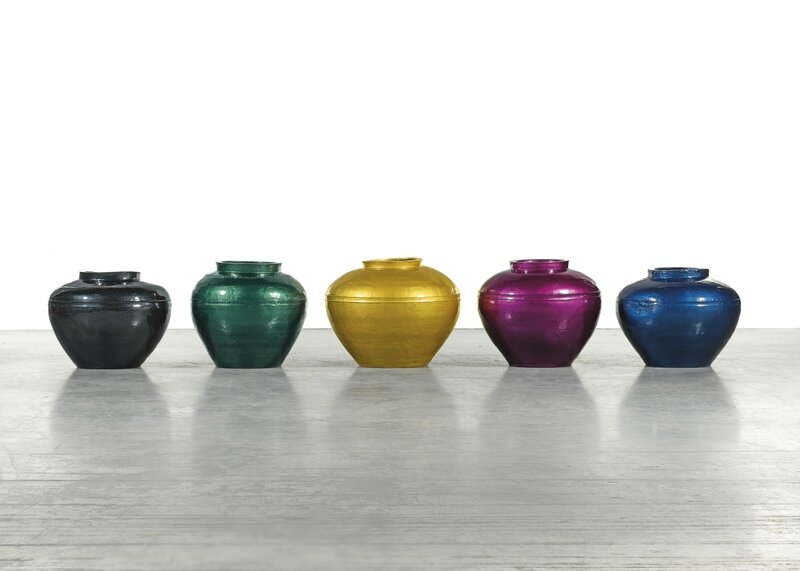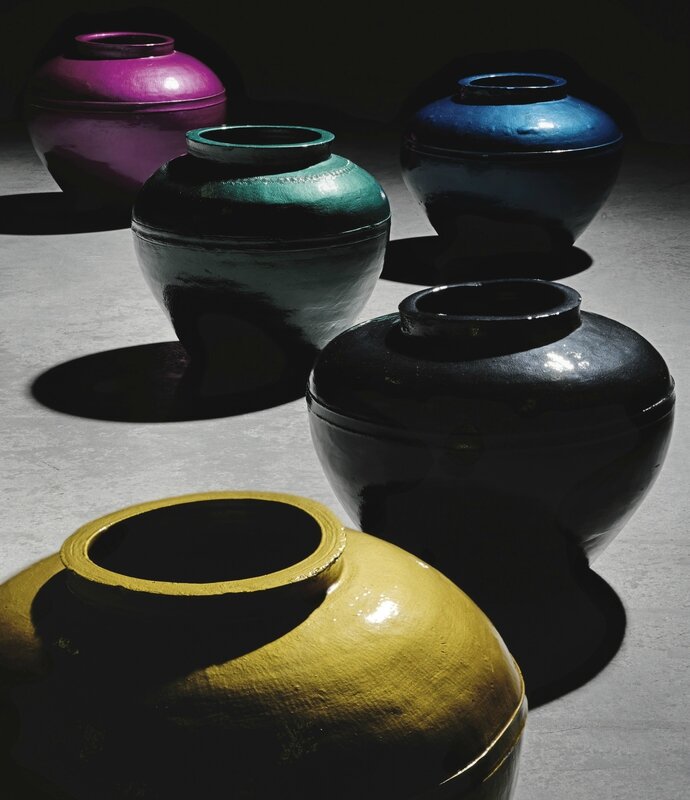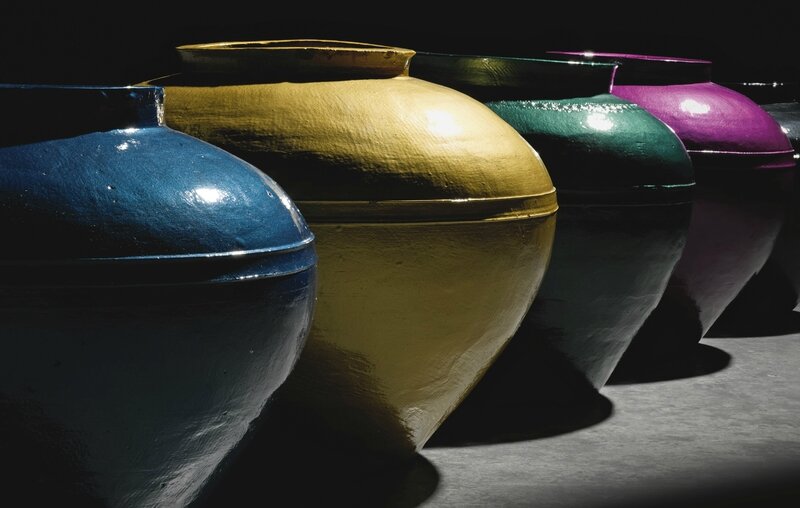Sotheby's. Contemporary Art Evening Auction, Londres, 28 juin 2016, 07:00 PM
Ai Weiwei (B. 1957), Han dynasty vases in auto paint, 2014
Lot 46. Ai Weiwei (B. 1957), Han dynasty vases in auto paint, signed, dated 2014 and numbered 5 on the bottom of the golden vase Han Dynasty vases in auto paint, in 5 parts. Executed in 2014, this work is unique. Estimate 180,000 — 250,000 GBP. Lot sold 191,000 GBP. Photo Sotheby's.
Provenance: Lisson Gallery, London
Acquired from the above by the present owner
Notes: Han Dynasty Vases in Auto Paint is a visually beguiling and conceptually loaded work that exemplifies the paradigm-shifting oeuvre of Ai Weiwei. It is irresistibly subversive, deftly dealing with themes of iconoclasm, globalisation, cultural heritage, and Chinese socio-economic change. The ancient urn is one of the most relied upon motifs in Ai’s iconological arsenal, having first been deployed in 1994. That he continues to use it after twenty years is testament, not only to his consummate satisfaction with the power of its message, but also to its continued relevance.
Ai was idiosyncratically iconoclastic in the execution of this work: in spraying five Han Dynasty urns from the Third Century BC with such a hard shiny shell of pigment, he effectively destroyed them, permanently altering their appearance and entirely negating their cultural significance. It is an inherently violent act, and the viewer is reminded of the artist’s celebrated triptych, Dropping a Han Dynasty Urn (1995), as well as of his long-standing political opposition to the Chinese government – opposition which saw him placed under house arrest for five years, and unable to travel outside of China until 2015 due to the confiscation of his passport. However, this work is about more than mere destruction. Through the completion of this vitriolic act, Ai created an original artwork of bold contrast and irreverent juxtaposition: old is forcibly conflated with new; the demure curves of Han Dynasty vases are chromed into the brash flatness of gold, purple, black, green, and blue; ancient reverence is sacrificed for capitalist aspiration, and an object of historic beauty is subsumed by the ornament of contemporary glamour. This constant interpretative counterpoint enlivens and enriches this work in a manner that typifies Ai’s conceptual verve.
The rapid development of China’s automotive industry presents a microcosm for the massive socio-economic change witnessed over the last thirty years in China; as the population and economy of the country boomed, so too did its production of cars. Where, in the late 1980s, China produced approximately two hundred thousand vehicles per year, in 2014, nearly 24 million were made, and the Chinese automotive industry is now the biggest in the world. Cars are symbols of societal progress and individual wealth, they emblematise the new China being irrevocably imprinted upon the old; thus, with this massive societal shift in mind, Ai Weiwei sprayed these five Han vases with a glossy coat of automotive paint. Just as China had survived millennia as a country without the impact of the car, so too these urns had survived unblemished for more than 2000 years before Ai imposed his visual language upon them. In the creation of this new body of work, the artist re-interprets revered artefacts of his culture in order to suit its ongoing evolution.
While the juxtapositions inherent to this work are immediately surprising, it was not created purely to shock. Moreover, while Ai Weiwei irrevocably altered the aesthetics of five ancient artefacts this is not a nihilistic piece solely created to deface and defile the relics of Chinese ancestry. These permanently altered vases herald the dawn of a new Chinese visual language, built on hereditary foundations, catalysed by the contemporary culture of global capitalism, and borne forth through the art of Ai Weiwei.

/https%3A%2F%2Fprofilepics.canalblog.com%2Fprofilepics%2F1%2F0%2F100183.jpg)
/https%3A%2F%2Fstorage.canalblog.com%2F03%2F02%2F119589%2F96711876_o.jpg)
/https%3A%2F%2Fstorage.canalblog.com%2F11%2F31%2F119589%2F94773502_o.jpg)
/https%3A%2F%2Fstorage.canalblog.com%2F20%2F83%2F119589%2F94772815_o.jpg)
/https%3A%2F%2Fstorage.canalblog.com%2F26%2F72%2F119589%2F75604929_o.jpg)
/https%3A%2F%2Fstorage.canalblog.com%2F59%2F60%2F119589%2F26458628_o.jpg)






/http%3A%2F%2Fstorage.canalblog.com%2F96%2F34%2F119589%2F129635008_o.jpg)
/http%3A%2F%2Fstorage.canalblog.com%2F03%2F37%2F119589%2F125979798_o.jpg)
/http%3A%2F%2Fstorage.canalblog.com%2F81%2F67%2F119589%2F121332217_o.jpg)
/http%3A%2F%2Fstorage.canalblog.com%2F50%2F81%2F119589%2F112699457_o.jpg)